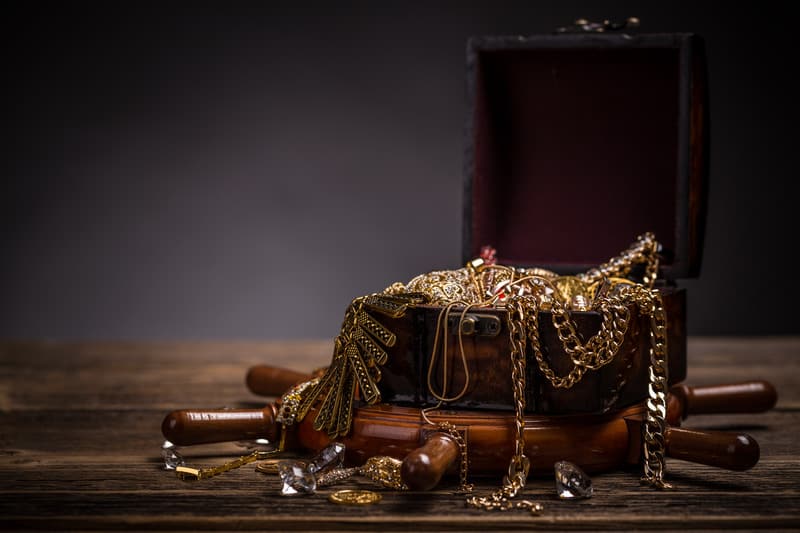7 Tips for Buying Gold in Dubai
Dubai is arguably the luxury shopping capital of the world, offering everything from deluxe brand names to some of the best custom work you will find anywhere. However, one item Dubai places above all else is gold, earning the city its nickname: the city of gold. Dubai has one of the largest gold markets in the world.
If you are in Dubai and looking to buy gold items, here are seven tips that will guarantee you the best shopping experience.
- Know your karats
- Know the current market prices for gold
- Check and ask for authentication
- Don’t be afraid to haggle
- Shop around
- Don’t be too stingy
- Learn about the best shopping spots
Buying gold in Dubai is pretty easy once you get the hang of it. However, for your first few times in the city, you may find the entire process a bit daunting, especially if you are from the west and not used to local trade customs.
While these tips we mentioned above may seem basic at first glance, fully understanding and applying them can be the difference between getting a quality piece for cheap, or paying double for low-grade goldware, especially on your first trip to Dubai.
Related Article:
Alright, let’s dive right in.
#1: Know Your Karats
One of the most critical concepts for the non-professional gold buyer to understand is that of karats. Without a working knowledge of what they are and how they work, is it’s super easy for an amateur buyer to fall into the common trap of overpaying for goldware.
Karats are a measure of the purity of any piece of gold. Hence, the higher the karat count, the more gold you are getting in the piece. Since the Karat scale stops at 24 karats, a 24 karat gold piece includes 100% pure gold with no additives, while a 12 karat gold jewelry is only half gold, with the other half made up by another metal.
| Karat | Gold Percentage |
| 24 | 100.00% |
| 18 | 75.00% |
| 14 | 58.33% |
| 12 | 50.00% |
| 10 | 41.66% |
The number of karats contained in a gold piece is one of the most significant determinants of its price. Consequently, knowing your karats like the back of your hand is one of the best ways to ensure you leave Dubai with the best possible deal on all your gold buys.
Why Gold is Sold in Karats
You may be wondering why gold is often sold in lower karats and rarely ever at its 24 karat purest, and the simple answer is durability and price.
Gold, in its pure form, is one of the more expensive metals per ounce, hence pure gold is quite impractical for the typical use cases of the average person. A lower karat piece gives you the chance to experience that luxurious feel gold brings without having to give up an arm and a leg.
Furthermore, pure gold is quite impractical for daily use, as, in this form, the metal is softer than most metals and faces a higher chance of physical or chemical damage. Consequently, with people who can afford pure gold items, they typically save these pieces for special occasions where there is a significantly lower risk of physical abuse.
Mixing gold with other metals also gives jewelers an increased ability to customize the color and texture of their end products. For example, rose gold jewelry contains significant percentages of copper that give it its distinct reddish look.
What Karat Should You Buy?
After understanding karats and the role they play, the next question typically is, “how many karats should you buy?” The best way to figure out what you should opt for is to base your decision on your intended use case for your gold jewelry.
Low-karat Gold pieces (10-14 karats): If you intend to buy gold for everyday use, low-karat jewelry is your best option. This additive-heavy alloys typically feature hard metals like nickel that reinforces the meld, significantly increasing durability. A low-karat construction is best for bracelets, rings, and other forms of adornments that get exposed to friction against hard surfaces regularly.
Mid-karat Gold Pieces (14-18 karats): If you wish to go up in quality and get a slightly more premium option, you should opt for choices with 14-18 karats. This category offers jewelry that adds more class that the low-karats, but is less durable yet tough enough to withstand everyday use if handled with care. Gold in this category is great for earrings and necklaces, which have a significantly lower chance of encountering any abrasion.
High-karat Gold Pieces (18-24 karats): high-karat gold offers the best of the best and consequently, the highest prices of the bunch. Compared to the other options, this type of gold is super delicate and prone to damage from even slight friction. Hence, the best use case for jewelry in this category is that added touch of elegance at special occasions and ceremonial events.
Which Gold Alloy is Right for You?
Next, you have to figure out which metal you want to be mixed in with your gold, and this choice boils down to your preferences for aesthetics and durability. Some metals like nickel can add a solid backbone to gold pieces, while options like silver and copper can give the meld a different, unique color.
Popular gold alloys include:
- White gold
- Yellow gold
- Rose, red, and pink gold
- Spangold
- Green gold
- Purple gold
- Blue gold
- Black gold
- Blue gold
Alternatively, if the main factor influencing your purchase is the price, you can opt instead for a gold plated option. Here, you are getting a piece of jewelry made from a different base metal that features a thin coating of gold. Hence you get items that look exactly like gold, but with a different core metal, and consequently, a significantly lower price.
However, if you choose to go the gold plated route, you should opt for the best of the best. Common problems with gold plated items include:
It’s hard to accurately gauge the right price for them as you cannot go by the gold content
The thin gold plating on lower-quality options are typically prone to wear (fading, chipping, or tarnishing) from minor friction
There is a deficient level of regulation in this market
Gold-plated items do not afford as much class as other options
#2: Know the Current Market Prices
One of the first ways to guarantee an excellent buying experience with any product is to know all about its current pricing. However, for gold, this can be a little complicated, especially for the uninitiated.
The keys to figuring out the right price for any gold piece falls into two main actions:
- Figuring out the price of gold per ounce
- Knowing the Markup
Figuring Out the Gold Price
Since gold is an internationally traded commodity, the cost of gold fluctuates on a minute to minute basis like any popular stock. Hence, your first step should be figuring out the price of gold per ounce/gram on the open market.
Thankfully, most stores in Dubai work with current international gold prices, and you can often see the real-time price of gold in AED boldly displayed at more shops. Alternatively, you can always check the current price of gold in AED from the Gold Price website.
However, you have little to fear when it comes to Dubai shops aligning their pricing with the current price of gold, as these stores receive regular checks from the Dubai police to guarantee price conformity. Nevertheless, being sure of the cost of gold can help increase your bargaining leeway and ensure you get the best deal possible, as you can easily calculate the markup on each item once you know the gold price and the number of karats.
Knowing the Markup
The most significant benefit to knowing the price of gold is that it can help you figure out the markup, that is how much you are paying for what isn’t gold—the other metal additives, the cost of labor on the piece, and the profit of the salesman.
Once you know the markup, you can better adjust your negotiating antics to get you the best deal possible.
Calculating the Markup
- To calculate the markup, all you need is:
- The weight of the item in troy ounces
- The number of karats
- The current gold price
Once you have these figures:
- First, multiply the weight of the item in troy ounces by the current gold price to get the cost of the piece if it were pure gold
- Then, multiply your result by the gold percentage of the item (karats divided by 24) to get the price of the gold content of the piece
- Subtract this price from the total amount of the item, and you have the markup that includes the cost of alloy, labor, and seller profit.
However, sometimes, the weight of the item is not available in troy ounces, but instead, you get weights in grams, grains, or pennyweights. To convert these figures into troy ounces, refer to the table below:
| Unit | Amount | In Troy Ounce | Formula |
| Pennyweights (dw) | 1 | 0.05 | divide the Pennyweights value by 20 |
| Grams (g) | 1 | 0.0321507 | divide the Grams value by 31.103 for approx. |
| Grains (gr) | 1 | 0.00208333 | Divide the Grains value by 0.00208333 |
#3: Check and Ask for Authentication
Once you’ve settled on the price, don’t forget to check or request for the following to ensure you are getting your money’s worth:
Karat Stamp or Hallmark
In most countries, the government requires that every piece of gold jewelry must include a clear stamp indicating the karats of the piece for easy verification. This karat stamping is usually in the form of imprinting by the production company stating the exact karats figure, or as a Hallmark, a purity rating system used for quality control in many European countries.
Although hallmarks systems can vary from country to country, many nations use a system derived from the Vienna Convention on the Control of the Fineness and the Hallmarking of Precious Metal Objects. An easy way to figure what a hallmark means is to refer to this handy Gold Hallmark Identification Wizard.
A karat stamp, on the other hand, is pretty straightforward as it directly tells you how much gold content the piece has.
Authentication Certificate
Similar to a hallmark or karat stamp, an authentication certificate offers another avenue for gold buyers to verify the gold content of their purchase. In Dubai, as part of the law, all buyers must receive an appropriate certification on request, and you should jump on this surety.
An authentication certificate typically details a comprehensive dissection of the item price. This report often includes karats, the item weight, the weight of its gold content, the weight of the other metals in the meld, and the cost of labor.
Vague Labeling
When buying gold, like with other forms of jewelry, the chances that you will encounter some sort of vague or misleading labeling, is quite high. Watch out carefully for terms like gold-colored, gold plate, and gold-tone and be sure that you know what they mean and what you are getting before you pull the trigger.
For example, a piece tagged 14 karat gold-plate is not a 14 karat piece but instead, just a fanciest gold plated item with another metal as it’s base.
An Invoice
Getting an invoice in most transactions is pretty much common sense as it gives you a solid proof to back your claims in case of any issues or when you want to confirm the price of the item to an interested third party.
While some traders may try to convince you to the contrary, it is quite standard for you to get an invoice with most purchases in Dubai, and we recommend you request one for every gold item you buy.
#4: Don’t Be Afraid to Haggle
While there is often no use bargaining at a fixed price US store, your typical Dubai gold shop is about the furthest thing from an outlet in a stateside shopping mall. In many parts of the Mediterranean world, the price tag is just a point where you start the conversation, and Dubai is no exception.
You are pretty much expected to haggle Dubai, and taking advantage of this chance to improve your deals while sharpening your negotiation skills is a no-brainer.
Here are some guidelines for creating the best experience while haggling at Dubai gold shops:
Keep Your Enthusiasm in Check
Yes, in Dubai gold shops, you will find some of the most beautiful and exciting pieces of jewelry you have ever laid your eyes upon. However, having and openly showing an “I’ve got to have that” mentality for any item is a recipe for getting overcharged, as a merchant that senses this will always play it to their advantage.
Remember to keep your poker face on point, especially at the beginning of the negotiation process and over the first couple of counter-offers. Furthermore, a slight frown as the seller mentions his first price will go a long way.
Flaunt Your Knowledge
By now, you know a great deal about figuring out the ideal price range for any gold item. Use this knowledge in the transaction.
The marked prices for items can often represent a significant bloating of the piece’s real value. Consequently, this smokescreen can disastrously affect the buyer’s goal of getting a good deal as they typically start bidding way higher than they should.
If you ignore the price tags, and start bidding at a more appropriate price, while supporting your bids with market information and related anecdotes, you are already a mile ahead of the other buying tourists that walk into the gold shops.
One of the best ways to improve your chances of a better outcome from the negotiation is to impress the gold merchant with your market knowledge.
Don’t Rush
Bargaining is a slow art that is rarely rushed. Hence, if you want to get better deals, you shouldn’t be in a hurry, and you should convey that in your mannerisms and body carriage.
The entire haggling process is a mental game, and the only way to guarantee the best results is to play it cool and adhere to the rules of the game, bargaining with respect while refusing to be pushed around.
Use the Third Person Narrative
If you have a friend with you during the purchase attempt—which we highly recommend, employ them in your negotiating antics by making them play the role of bad cop.
Your friend could worry about your budget, complain about the item price, or asking to leave and return to the hotel out of boredom. Any of these reactions subliminally put the heat on the merchants and increases his chances of offering you a deal you can’t refuse soon enough.
Offer Cash
At most gold stores that sell high ticket items, tourists often pay with credit cards, but taking this route may be shooting yourself in the foot. Merchants are typically more likely to offer you a better deal if you pay cash as they get to keep all of the potential credit-card fees.
Furthermore, it helps if you hold your cash in hand, indirectly showing the seller your money throughout the negotiation process. This tactic often increases your chances of getting improved deals as it offers a form of constant temptation to the merchant.
Don’t Be Afraid to Leave
Remembering you always have the choice of leaving at any point during the transaction is one of the best psychological and financial boosts, you can give your chances of getting the best deal possible.
The onus is on the merchant to close the sale as he wants your business; hence, mentioning or exercising your ability to leave is a great way to get them to play ball.
Furthermore, many sellers will not offer you their best price until you start to leave, and the figure the merchant shouts at you as you turn the corner is probably the best price you’ll get anywhere.
Request a Multiple Item Discount
If you are buying more than one piece of jewelry at a particular store, you should be getting a discount. Ask for it.
Test to see if the merchant will give you a discount on bulk purchases as most sellers will be more flexible on such deals than with a single purchase.
A great way to have more bargaining power using this tip is to assemble most of your gold shopping into one big purchase.
However, don’t be tempted into buying more than what you need to get a bargain if your goal is to save money, and you don’t want to turn your Dubai trip into a wallet-wrecking shopping spree.
Go Shopping at the Right Time
The best time to haggle is near the end of the day, as merchants are more likely to offer discounted prices to enable them to close a few more deals before they lock up for the day.
#5: Shop Around
An excellent way to get overcharged on jewelry in Dubai is to see an item you love and fall into the trap of thinking you won’t get something in that class anywhere else. This false feeling is a recipe for some lousy negotiation as it psychologically reduces your ability to haggle properly.
Unlike what you may be led to believe by merchants in Dubai, the extent of the gold market in the city ensures that you can find most gold items or similar variants in several different shops. So, there is no point sticking to the piece in one shop if you gauge the offers you are getting as unfavorable.
Hence, a good rule of thumb is to check for an item in at least three shops before buying. Prices for similar items can vary significantly from gold shop to gold shop, even for those in the same stall.
Furthermore, the experience you get from shopping around the Dubai gold shops will, in a short while, give you a feel for the market, the haggling process, and what constitutes a reasonable price.
#6: Don’t Be too Stingy
While haggling is considered an appropriate custom in this region, you must know when to insist on getting the best deal, or when to throw in the towel and pay a slight premium, especially if the price is already in the range you consider fair.
While a few extra bucks won’t have a significant impact on your financial situation, for some merchants, especially the smallest shops, it could mean everything. While many traders will attempt to play this card and pull your heartstrings, some times, acquiescing and accepting a slightly higher price may be worth it.
Here, there are no cold hard rules. Gauge the situation and follow your intuition.
#7: Learn about the Best Shopping Spots
While Dubai is the City of Gold, you must know where to look if you want to get the best deals. Shopping at the hottest gold spots offers you a chance to search through a more extensive database of gold items and jewelry, compare prices, and get the best deals.
Where to Buy Gold in Dubai
Deira Gold Souk (Al Ras, Dubai)
One of the best places where to buy gold in Dubai for shopping gold is hands down the Deira Gold Souk in Old Dubai. This shopping district is dedicated to gold, and house more than 300 gold jewelry shops, offering an assortment of shopping options and some of the best prices you will find anywhere.
In addition to gold shops, at the Deira Gold Souk, you get to experience an authentic version of old Dubai culture, as the gold market is one of the oldest souks in the city. Consequently, the Gold Souk in Deira is an accessible location for tourists and also the perfect place to start shopping gold.
Also you can also buy gold in the Dubai Mall.
The Gold Souk Dubai Mall (Dubai Mall, Dubai)
If you would instead ditch the culture theme and opt for a more modern shopping experience, the best gold souk at the Dubai mall is your best bet. This indoor market offers a similar assortment of products you will find at the Deira Gold Souk with a modern Dubai vibe.
The Gold Souk Dubai Mall is a favorite location for gold-buying visitors to Dubai.
The Gold and Diamond Park (Al Quoz 3, Dubai)
Don’t let the “park” tag fool you, as you do not get to shop gold while strolling through the grass, but you get the next best thing: an air-conditioned mall with all the gold you’ll ever need. With over 70 jewelry stores, the Gold and Diamond Park offers some of the best selection of gold outlets in Dubai.
Gold Outlets in Malls Around the City
If you do not have the time to deal with market antics, you may be more suited to a shopping outlet in one of Dubai’s many malls. Thankfully, there is no shortage of options for you. Popular gold outlets you can find around Dubai include:
- Damiani (Dubai Mall, Dubai)
- Damas Jewelry (multiple locations)
- Malabar Gold and Diamonds (various locations)
- Joyalukkas (multiple locations)




